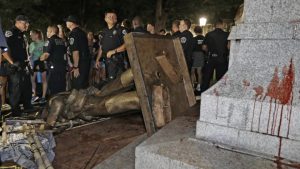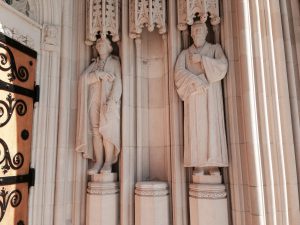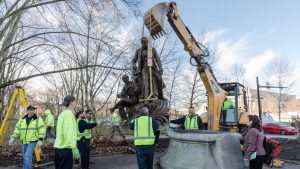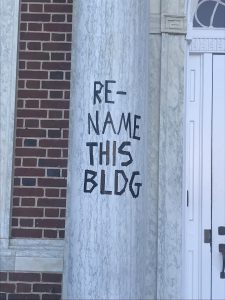
From Mav: Once again, we’re in a situation where fortune calls upon us and I am presented with an idea for an episode related to an episode I was already recording. While I was working on the kneeling for the national anthem call for comments, Katya texted me to tell me that a group of protestors at the University of North Carolina had toppled a confederate statue known as “Silent Sam.” The statue had been commissioned in 1913 to commemorate the students from the university that fought for the South in the Civil War… you know, the bad guys. Katya asked if we’d like to do an episode on it. Of course we do!
 Protesting and removing racist monuments is kind of big business right now. There’s obviously the whole tragedy in Charlottesville. But there’s been several others. right down the street from UNC at Duke (where Katya goes to school and works), the administration removed a statue commemorating Robert E. Lee just last year. This was done after Charlottesville, largely to avoid this kind of thing.
Protesting and removing racist monuments is kind of big business right now. There’s obviously the whole tragedy in Charlottesville. But there’s been several others. right down the street from UNC at Duke (where Katya goes to school and works), the administration removed a statue commemorating Robert E. Lee just last year. This was done after Charlottesville, largely to avoid this kind of thing.
 Even up here in the Northern Yankee land of Pittsburgh, we have similar issues. While it’s not a “confederate statue” per se, complaints about a statue of composer Stephen Foster towering over a black man resulted in that statue being removed earlier this year. Of course, what makes this interesting is that the statue is currently in storage while they decide what to do with it, and other cities are specifically showing an interest in having it moved there. In other words, the city doesn’t so much want there to be no racist monuments, so much as they want the monuments to racism to be confined to racist cities.
Even up here in the Northern Yankee land of Pittsburgh, we have similar issues. While it’s not a “confederate statue” per se, complaints about a statue of composer Stephen Foster towering over a black man resulted in that statue being removed earlier this year. Of course, what makes this interesting is that the statue is currently in storage while they decide what to do with it, and other cities are specifically showing an interest in having it moved there. In other words, the city doesn’t so much want there to be no racist monuments, so much as they want the monuments to racism to be confined to racist cities.
So much attention is being drawn to these statues lately, between the moves to get these statues removed and certain groups that want to preserve them, that I’d say they clearly count as “popular culture” and since that’s what we do on this show, I figured we’d take a look at the history of why there are so many statues, and the reasons that people have for both wanting to remove them and preserve them. What is the cultural statement that is made by statues and by taking them down?
As always, we want to know from you. So what are your thoughts and questions? What should we address?
From Katya: There’s already been a lot of good coverage of Silent Sam that I’ll avoid repeating (if you need to catch up here are some suggestions)

The short version of it is that this has been a long time coming, with different protests of Silent Sam being initiated by different anti-racist groups for about half a century. The statue has created tension since its dedication in 1913 by Confederate veteran and UNC Trustee Julian Carr with a speech celebrating white supremacy . In the past year the region has also seen the removal of the statue at Duke that Mav mentions above as well as the toppling of another monument in Durham. There have been ongoing debates at universities across the country about how to deal with Confederate and other racist monuments as well as buildings named after white supremacists. On my first day back on Duke’s campus I passed by tape reading “Re-name this building” on the pillars of the Carr Building, named after the same Julian Carr that spoke at the dedication of Silent Sam.
Regular listeners can imagine were my sympathies lay. This week I was accused of being a “book-burner” on social media after posting a photo of the toppled statue. The original poster’s premise was the usual one: we’re supposed to preserve art and history, that there is something of value here. (Ignore the history of racism and discrimination, ignore also its relationship to the ongoing practices of the institutions which tolerate them.)
Dismantling symbols of white supremacy on university campuses is not book burning, it’s intellectual discourse in action. As many commentators have noted already, public art conveys ideological messages. Whether you agree with that message or not, it functions as propaganda. This is particularly true in cases like Silent Sam where there is little context for the larger historical context of the statue. Many have accused the activists of “mob rule” and a lack of intellectual dialogue however many of the protests have hinged on contextualizing Silent Sam’s sanitized version of history. (I highly encourage readers to take a look at this interview with activist and graduate student Maya Little who is facing vandalism charges for providing that context in April.) In other words, they have hinged upon providing the intellectual dialogue that the statue itself fails to provide.
Some have been lamenting the destruction of a historical artifact and a work of art. Yet art doesn’t end when the author puts down their pen or the sculptor walks away from the installation of their work. It includes the ongoing history, circulation, and dialogue that surrounds that work. When we teach a work of art part of our job is to situate it in its historical context, to explain not only the content of the text itself but to discuss how it related to the time in which it was generated and in turn how it relates to us now. The protest, destruction, or removal of a work of art is part of the work’s ongoing history, part of the text itself, particularly when protest of that work is motivated by history, knowledge, and personal experience.


If you have the time, Gimlet has a podcast called Uncivil. The episode Spin talks about statues etc.
The link includes a transcript. Episodes are about 30 minutes.
https://www.gimletmedia.com/uncivil/the-spin#episode-player
I’ve repeatedly seen and heard people claim that removing these monuments is an attempt to erase history, and that’s nonsense. In cities where officials have opted to move the monuments to museums or Civil War memorials where they can be displayed in context, that’s been largely considered a reasonable option because nobody is trying to pretend the war didn’t happen; people who want them removed just don’t want statues of Confederate figures displayed in what appear to be positions of honor, as if their cause was somehow noble. It simply wasn’t and pretending otherwise is much more of a history erasure than saying “maybe this doesn’t belong outside our city hall”.